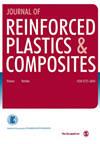Mechanical enhancement of natural-fiber-reinforced composites modified with recycled thermoset composite fillers
IF 2.2
3区 材料科学
Q3 MATERIALS SCIENCE, COMPOSITES
引用次数: 0
Abstract
Synthetic-fiber-reinforced thermoset composites pose a significant threat of environmental pollution owing to their nonbiodegradable nature. To address this issue, it is essential to establish an adequate recycling strategy to reduce composite waste. In this study, we prepared flax-fiber-reinforced thermoplastic composites and modified a liquid thermoplastic resin (Elium 188 O) with recycled thermoset composite fillers. The introduction of 15% silane-treated fillers into the polymer matrix resulted in a substantial increase in the energy release rate and fracture toughness at the fracture initiation stage in modes I and II. Specifically, compared with the unmodified matrix, the energy release rate and fracture toughness were enhanced by 44.8% and 42.8% (for mode I) and 40.5% and 85.4% (for mode II), respectively. Similarly, the flexural strength and modulus increased by 25.1% and 34.8%, respectively. Furthermore, the mechanical properties of thermoplastic composites will deteriorate significantly because of the low bonding strength between virgin and recycled materials. However, the flax-fiber-reinforced composites with a 15% silane-treated filler-modified polymer matrix maintained Young’s modulus and tensile strength of 89.9% and 91.2%, respectively, after 20 cycles of recycling. Overall, the strategy of inducing chemical-treated powdered composite wastes is a sufficient and low-labor-cost method to mitigate environmental pollution and improve the sustainability of recycled composite structures.用回收热固性复合填料改性的天然纤维增强复合材料的机械性能提升
合成纤维增强热固性复合材料由于其不可生物降解的特性,对环境污染构成了重大威胁。为解决这一问题,必须制定适当的回收策略,以减少复合材料废弃物。在这项研究中,我们制备了亚麻纤维增强热塑性复合材料,并用回收的热固性复合材料填料改性了液态热塑性树脂(Elium 188 O)。在聚合物基体中引入 15% 的硅烷处理填料后,在模式 I 和模式 II 的断裂起始阶段,能量释放率和断裂韧性都有了大幅提高。具体来说,与未改性基体相比,能量释放率和断裂韧性分别提高了 44.8%和 42.8%(模式 I)以及 40.5%和 85.4%(模式 II)。同样,弯曲强度和模量也分别提高了 25.1%和 34.8%。此外,由于原生材料和回收材料之间的粘合强度较低,热塑性复合材料的机械性能会明显降低。然而,采用 15% 硅烷处理填料改性聚合物基体的亚麻纤维增强复合材料在循环使用 20 次后,杨氏模量和拉伸强度分别保持在 89.9% 和 91.2%。总之,诱导化学处理粉末状复合材料废料的策略是一种充分且低劳动力成本的方法,可减轻环境污染并提高再生复合材料结构的可持续性。
本文章由计算机程序翻译,如有差异,请以英文原文为准。
求助全文
约1分钟内获得全文
求助全文
来源期刊

Journal of Reinforced Plastics and Composites
工程技术-材料科学:复合
CiteScore
5.40
自引率
6.50%
发文量
82
审稿时长
1.3 months
期刊介绍:
The Journal of Reinforced Plastics and Composites is a fully peer-reviewed international journal that publishes original research and review articles on a broad range of today''s reinforced plastics and composites including areas in:
Constituent materials: matrix materials, reinforcements and coatings.
Properties and performance: The results of testing, predictive models, and in-service evaluation of a wide range of materials are published, providing the reader with extensive properties data for reference.
Analysis and design: Frequency reports on these subjects inform the reader of analytical techniques, design processes and the many design options available in materials composition.
Processing and fabrication: There is increased interest among materials engineers in cost-effective processing.
Applications: Reports on new materials R&D are often related to the service requirements of specific application areas, such as automotive, marine, construction and aviation.
Reports on special topics are regularly included such as recycling, environmental effects, novel materials, computer-aided design, predictive modelling, and "smart" composite materials.
"The articles in the Journal of Reinforced Plastics and Products are must reading for engineers in industry and for researchers working on leading edge problems" Professor Emeritus Stephen W Tsai National Sun Yat-sen University, Taiwan
This journal is a member of the Committee on Publication Ethics (COPE).
 求助内容:
求助内容: 应助结果提醒方式:
应助结果提醒方式:


